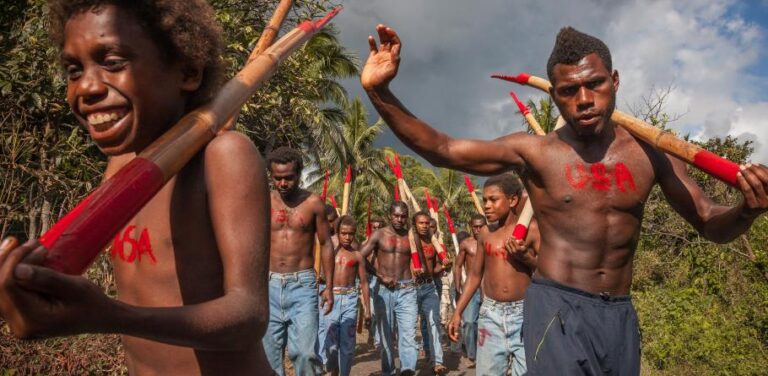Introduction to Cargo Cults
Cargo cults are religious movements that emerged in Melanesia, a region of the Pacific Islands, during the 20th century. These movements were characterized by the belief that the arrival of Western goods and technology, known as “cargo,” was the result of supernatural powers or divine intervention. The followers of cargo cults believed that by performing rituals and ceremonies, they could attract the arrival of more cargo and achieve prosperity and abundance.
The term “cargo cult” was coined by Western anthropologists who observed these movements and noted their focus on material goods and technology. However, the cargo cults themselves did not use this term, and their beliefs and practices varied widely from one group to another. Some cargo cults were peaceful and focused on communal sharing and cooperation, while others were more militant and aggressive, seeking to overthrow colonial powers and establish their own independent states.
The History and Origins of Cargo Cults
The origins of cargo cults can be traced back to the arrival of Western explorers and traders in Melanesia in the late 19th century. These encounters brought new technologies, goods, and ideas to the region, which were often seen as magical or supernatural by the indigenous populations. The first cargo cults emerged in the early 20th century, in response to the disruptions caused by colonialism, missionary activity, and World War I.
One of the most well-known instances of cargo cult activity took place among the indigenous people of Melanesia in the period surrounding World War II. During this time, these islanders witnessed the largest war ever fought by technologically advanced nations, often right in front of their homes. The Japanese took advantage of the Melanesians’ beliefs to try and gain their compliance by distributing goods. Eventually, the Allied forces also arrived on the islands.
The islanders experienced significant changes in their way of life due to the abundance of military equipment and supplies that were airdropped or airlifted to troops on the islands. For many of them, this was their first encounter with outsiders. The soldiers received a wide variety of goods like manufactured clothing, medicine, canned food, tents, and weapons, which they shared with the islanders who acted as their guides and hosts. The Japanese Army also followed this practice initially before things turned sour in most regions.
One of the earliest and most famous cargo cults was the Tanna Island movement in Vanuatu, which emerged during the 1930s. The followers of this movement believed that a mythical figure named John Frum, who was said to be a US serviceman, would bring them cargo and prosperity. They built elaborate ceremonial structures and performed rituals to attract his arrival, and even created a mock airstrip to facilitate his landing.
The Beliefs and Practices of Cargo Cults
After the military left the airbases following the war, the locals in remote Melanesian populations were promised deliveries of food, arms, Jeeps, and other goods by charismatic cult leaders. The leaders claimed that the cargo would come from their own ancestors or other sources, just like it did when outsider armies were present. To try and get cargo to fall by parachute or land in planes or ships again, islanders imitated the practices they had seen the military personnel use. They mimicked the day-to-day activities and dress styles of US soldiers, performed parade ground drills with wooden or salvaged rifles, carved headphones from wood and wore them while sitting in fabricated control towers, waved the landing signals while standing on the runways, and lit signal fires and torches to light up runways and lighthouses.
The beliefs and practices of cargo cults varied widely from one group to another, but they all shared a focus on material goods and technology as symbols of power and prosperity. Many cargo cults believed in the existence of supernatural beings or spirits who controlled the arrival of cargo and could be appeased through rituals and offerings. These rituals often involved dancing, singing, and the use of ceremonial objects, such as bamboo poles, flags, and masks.
Some cargo cults also incorporated elements of Christianity, such as the use of hymns, prayers, and biblical stories. However, they often interpreted these elements in their own unique ways, incorporating local traditions and beliefs. For example, the followers of the Tanna Island movement saw John Frum as a messianic figure who would liberate them from colonial rule and bring them prosperity, while also incorporating elements of Christian prophecy and apocalypse.
Famous Cargo Cults and Their Stories
There have been many famous cargo cults throughout history, each with its own unique story and legacy. One of the most well-known is the John Frum movement on Tanna Island, which continues to this day and attracts tourists and scholars from around the world. Another famous cargo cult is the Prince Philip movement in Vanuatu, which emerged in the 1950s and venerates the Duke of Edinburgh as a divine figure.
Other notable cargo cults include the Cargonauts on New Guinea, who believed that a mythical figure named Tom Navy would bring them goods and technology, and the Vailala Madness in Papua New Guinea, which was characterized by a frenzied pursuit of cargo and led to violence and social upheaval. These movements have inspired countless books, films, and documentaries, and continue to fascinate and intrigue scholars and travellers alike.
Misconceptions and Myths About Cargo Cults
There are many misconceptions and myths about cargo cults that have circulated in Western popular culture. One of the most common is the belief that cargo cults are primitive and irrational and that their followers are gullible and superstitious. However, this view ignores the complex historical and cultural contexts in which cargo cults emerged, and how they reflect indigenous peoples’ responses to colonialism and modernity.
Another myth about cargo cults is that they are extinct or dying out, and that they belong to a bygone era of colonialism and anthropology. However, many cargo cults continue to exist and thrive in the Pacific Islands and other parts of the world, and they continue to evolve and adapt to changing cultural and political contexts.
Cargo Cults in Modern Times
Cargo cults have continued to evolve and adapt to the modern world, as indigenous peoples confront new forms of external control and globalization. Some cargo cults have become more militant and political, seeking to challenge the dominant power structures and assert their own sovereignty and independence. Others have become more focused on environmental and cultural preservation, seeking to protect their traditional ways of life from the destructive impacts of modernization and development.
One example of a modern cargo cult is the Kanak Socialist National Liberation Front in New Caledonia, which emerged in the 1980s and sought to achieve independence from France through armed struggle. Another example is the Cargo Cult Science movement, which emerged in the United States in the 1970s and critiqued the scientific establishment for its focus on materialism and reductionism.
While Cargo Cults remain something of a rarity worldwide, the underlying behaviour still permeates through our cultures and organisations and is better known as Social Mimicry.
Social Mimicry
Social mimicry, also known as the chameleon effect, refers to the tendency of people to unconsciously mimic the behaviours and actions of those around them. In the business world, this can lead to the adoption of certain practices, processes, or frameworks without fully understanding the underlying principles or evaluating their potential drawbacks.
One negative effect of social mimicry is the creation of a herd mentality. When employees mimic the behaviours of their colleagues or superiors without questioning them, it can lead to a lack of critical thinking and analysis. This can result in a culture of conformity, where new ideas are not welcomed, and innovation is stifled. This can ultimately hinder a company’s ability to adapt to changes in the market and remain competitive.
Another negative effect of social mimicry is the adoption of practices or frameworks that are not suitable for a particular business or industry. Businesses may blindly follow the practices of successful companies without considering whether they are relevant or feasible for their own operations. This can lead to wasted resources, lost productivity, and a failure to achieve business objectives.
Furthermore, social mimicry can also lead to a lack of diversity in the workplace. When employees unconsciously mimic the behaviours of those around them, it can create a homogenous workplace where new ideas and perspectives are not valued. This can lead to a lack of innovation, decreased creativity, and a failure to address the unique challenges facing a particular business or industry.
Conclusion
Cargo cults can offer a valuable lesson to businesses blindly following new frameworks and the latest business fads. The Islanders believed that performing certain rituals would bring more material goods and technology to their communities, without understanding the underlying principles behind them. Similarly, in the business world, companies often follow the latest business fad without fully understanding their underlying principles, benefits, and drawbacks. The last point, drawbacks, is critical because all frameworks and methodologies have drawbacks but are often sold into organisations as only having 100% upside.
Blindly adopting practices, processes, or frameworks without understanding their underlying principles or evaluating their potential drawbacks can lead to a lack of critical thinking, a herd mentality, wasted resources, and a lack of diversity. To avoid these negative effects, it is crucial for businesses to engage in critical thinking, analysis, and evaluation before adopting new practices or frameworks.


